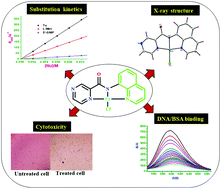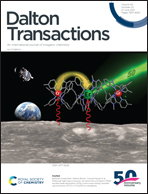Role of π-conjugation on the coordination behaviour, substitution kinetics, DNA/BSA interactions, and in vitro cytotoxicity of carboxamide palladium(ii) complexes†
Abstract
Treatments of N-(pyridin-2-ylmethyl)pyrazine-2-carboxamide (L1), N-(quinolin-8-yl)pyrazine-2-carboxamide (L2), N-(quinolin-8-yl)picolinamide (L3) and N-(quinolin-8-yl)quinoline-2-carboxamide (L4) with [PdCl2(NCMe)]2 afforded the corresponding Pd(II) complexes, [Pd(L1)Cl] (PdL1); [Pd(L2)Cl] (PdL2); [Pd(L3)Cl] (PdL3); and [Pd(L4)Cl] (PdL4) in moderate yields. Structural characterisation of the compounds was achieved by NMR and FT-IR spectroscopies, elemental analyses and single crystal X-ray crystallography. The solid-state structures of complexes PdL2–PdL4 established the presence of one tridentate carboxamide and Cl ligands around the Pd(II) coordination sphere, to give distorted square planar complexes. Electrochemical investigations of PdL1–PdL4 showed irreversible one-electron oxidation reactions. Kinetics reactivity of the complexes towards bio-molecules, thiourea (Tu), L-methionine (L-Met) and guanosine 5′-diphosphate disodium salt (5′-GMP) decreased in the order: PdL1 > PdL2 > PdL3 > PdL4, in tandem with the density functional theory (DFT) data. The complexes bind favourably to calf thymus (CT-DNA), and bovine serum albumin (BSA), and the order of their interactions agrees with the substitution kinetics trends. The in vitro cytotoxic activities of PdL1–PdL4 were examined in cancer cell lines A549, PC-3, HT-29, Caco-2, and HeLa, and a normal cell line, KMST-6. Overall, PdL1 and PdL3 displayed potent cytotoxic effects on A549, PC-3 HT-29 and Caco-2 comparable to cisplatin. All the investigated complexes exhibited lower toxicity on normal cells than cisplatin.



 Please wait while we load your content...
Please wait while we load your content...